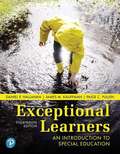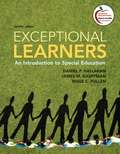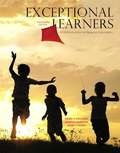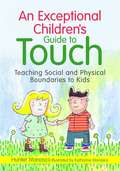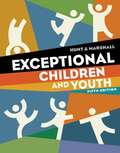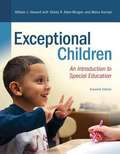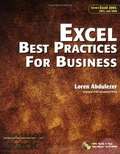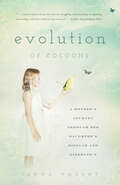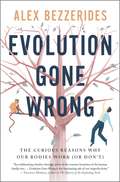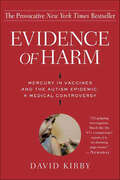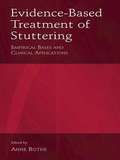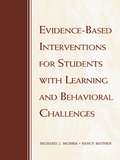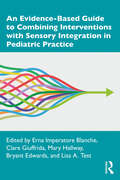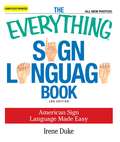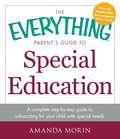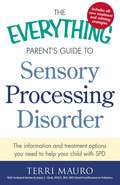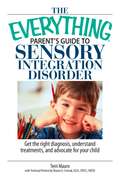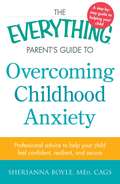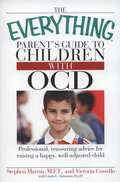- Table View
- List View
Exceptional Learners: An Introduction to Special Education
by Daniel P. Hallahan James M. Kauffman Paige C. PullenAn up-to-date introduction to the characteristics of exceptional learners and their education <P><P>Exceptional Learners: An Introduction to Special Education focuses on exceptional learners and classroom practices, as well as the psychological, sociological, and medical aspects of disabilities and giftedness. <P><P>Based on the authors’ premise that professionals working with exceptional learners need to develop not only a solid base of knowledge, but also a healthy attitude toward their work and the people whom they serve, this book is designed to reach the heart as well as the mind. It asks both general and special educators to challenge themselves to acquire a solid understanding of current theory, research, and practice in special education, and to develop an ever more sensitive understanding of exceptional learners and their families. <P><P>The 14th Edition includes the new definitions of Specific Learning Disorder, Attention Deficit Hyperactivity Disorder (ADHD), Emotional and Behavioral Disorders, and Autism Spectrum Disorders (ASD) from the American Psychiatric Association’s DSM-5, along with expanded coverage of topics like Universal Design for Learning, Multi-Tiered System of Supports (MTSS), and Positive Behavioral Interventions and Supports (PBIS).
Exceptional Learners: An Introduction to Special Education (12th Edition)
by Daniel P. Hallahan James M. Kauffman Paige C. PullenExceptional Learners is an outstanding introduction to the characteristics of exceptional learners and their education, emphasizing classroom practices as well as the psychological, sociological, and medical aspects of disabilities and giftedness. In keeping with this era of accountability, all discussions and examples of educational practices are grounded in a sound research base. With hundreds of new references added to the 12thedition, the authors are committed to bringing the most current and credible perspectives to bear on the ever-increasing complexity of educating students with special needs in today's schools. The authors have written a text that reaches the heart as well as the mind, promoting a conviction that professionals working with exceptional learners need to develop not only a solid base of knowledge, but also a healthy attitude toward their work and the people whom they serve, and constantly challenge themselves to acquire a solid understanding of current theory, research, and practice in special education and to develop an ever more sensitive understanding of exceptional learners and their families.
Exceptional Learners: An Introduction to Special Education (Thirteenth Edition)
by Daniel P. Hallahan James M. Kauffman Paige C. PullenIn Exceptional Learners by Hallahan, Kauffman, and Pullen, readers get an up-to-date introduction to the characteristics of exceptional learners and their education that emphasizes classroom practices, as well as the psychological, sociological, and medical aspects of disabilities and giftedness. Based on the author’s premise that professionals working with exceptional learners need to develop not only a solid base of knowledge, but also a healthy attitude toward their work and the people whom they serve, this book is designed to reach the heart as well as the mind. It asks both general and special educators to challenge themselves to acquire a solid understanding of current theory, research, and practice in special education, and to develop an ever more sensitive understanding of exceptional learners and their families.
An Exceptional Children's Guide to Touch: Teaching Social and Physical Boundaries to Kids
by McKinley Hunter ManascoThe rules of physical contact can be tricky to grasp and children with special needs are at a heightened risk of abuse. This friendly picture book explains in simple terms how to tell the difference between acceptable and inappropriate touch, thereby helping the child with special needs stay safe. <P><P>Each story covers a different type of touch from accidental to friendly to hurtful and will help children understand how boundaries change depending on the context. It explores when and where it is okay to touch other people, when and where other people can touch you, why self touching sometimes needs to be private, and what to do if touch feels inappropriate. <P><P>This book is an invaluable teaching resource and discussion starter for parents, teachers and carers working with children with special needs.
Exceptional Children And Youth
by Nancy Hunt Kathleen MarshallEXCEPTIONAL CHILDREN AND YOUTH, Fifth Edition, provides a concise yet complete introduction to special education for pre-service and in-service teachers. One of the most accessible and readable texts available for the Introduction to Special Education course, this new edition is thoroughly updated to reflect the most current information available about special education practice and children with exceptionalities. The text emphasizes current research and theory about exceptional children, human diversity, inclusion, law and social policy, family involvement, real-life stories about exceptionality, and evidence-based teaching practices--all presented in a warm, personal narrative style.
Exceptional Children: An Introduction To Special Education (Eleventh Edition)
by William L. HewardThis package includes the REVEL(tm) access card and loose-leaf version. REVEL is Pearson's newest way of delivering our respected content. Fully digital and highly engaging, REVEL replaces the textbook and gives students everything they need for the course. Informed by extensive research on how people read, think, and learn, REVEL is an interactive learning environment that enables students to read, practice, and study in one continuous experience--for less than the cost of a traditional textbook. An informative, accessible, and interesting introduction to the ongoing story of special education. Special education is an ongoing story of people-of exceptional children, of the families of children with special needs, and of the teachers who work with them. Exceptional Children: An Introduction to Special Education focuses on 15 experienced teachers to give readers first-person insight into this diverse field. It also details, step-by-step, how special educators use highly effective, research-based practices to promote student achievement in their classrooms. The Eleventh Edition includes new information that reflects the current professional practices, trends, and research that define the exciting and ever-evolving field of special education. NOTE: Before purchasing, check with your instructor to ensure you select the correct ISBN. Several versions of Pearson's products exist for each title*, and registrations are not transferable. In addition to the access card included in this package, you will need a course invite link, provided by your instructor, to register for and use REVEL. Used books, rentals, and purchases made outside of Pearson If purchasing or renting from companies other than Pearson, the access code for REVEL may not be included, may be incorrect, or may be previously redeemed. Check with the seller before completing your purchase. 0134027116 / 9780134027111 REVEL for Exceptional Children: An Introduction to Special Education with Loose-Leaf Version Package consists of: 013420140X / 9780134201405 Exceptional Children: An Introduction to Special Education, Loose-Leaf Version 0134303288 / 9780134303284 REVEL for Exceptional Children: An Introduction to Special Education -- Access Card * REVEL features such as embedded videos, exercises, and quizzes are only available in the REVEL format. They are not available in third-party eTexts or downloads.
Exceptional Children: An Introduction to Special Education (10th Edition)
by William L. HewardExceptional Children: An Introduction to Special Education has always been known for its innovation, strong research base and accessibility. The tenth edition has all of those strengths, but has a greater focus on highly effective, research-based practices that are described in a very step-by-step, applied manner. Heward presents an informative and responsible introduction to the professional practices, trends, and research that define contemporary special education while also conveying the diversity and excitement of this changing field. The book is for those teachers who will be professionals in the area of special education or those who are working with students that have exceptionalities.
Excel Best Practices for Business
by Loren AbdulezerHow to create, manage, and validate spreadsheets that will stand up to scrutiny and provide a clear and accurate picture of your enterprise.
Evolution of Cocoons: A Mother's Journey Through Her Daughter's Mental Illness and Asperger's
by Janna Vought"Destiny presented me with a situation that affords me access to a most strange, sometimes frightening, beautiful, and always intriguing world." Evolution of Cocoons is a firsthand account of mothering a child who suffers from debilitating mental and developmental illnesses. The book offers readers an intimate glimpse into the life of a family reeling from the effects of such diseases; everyone is brave and flawed. It is an honest, brutal, introspective, and searching look into a life corrupted by a child's imbalanced mind and a mother's search for strength.
Evolution Gone Wrong: The Curious Reasons Why Our Bodies Work (Or Don't)
by Alex Bezzerides&“An unforgettable journey through this twisted miracle of evolution we call &‘our body.&’&” —Spike Carlsen, author of A Walk Around the BlockFrom blurry vision to crooked teeth, ACLs that tear at alarming rates and spines that seem to spend a lifetime falling apart, it&’s a curious thing that human beings have beaten the odds as a species.After all, we&’re the only survivors on our branch of the tree of life. The flaws in our makeup raise more than a few questions, and this detailed foray into the many twists and turns of our ancestral past includes no shortage of curiosity and humor to find the answers.Why is it that human mothers have such a life-endangering experience giving birth? Why are there entire medical specialties for teeth and feet? And why is it that human babies can&’t even hold their heads up, but horses are trotting around minutes after they&’re born?In this funny, wide-ranging and often surprising book, biologist Alex Bezzerides tells us just where we inherited our adaptable, achy, brilliant bodies in the process of evolution.
Evidence of Harm: Mercury in Vaccines and the Autism Epidemic: A Medical Controversy
by David KirbyIn the 1990s reported autism cases among American children began spiking, from about 1 in 10,000 in 1987 to a shocking 1 in 166 today. This trend coincided with the addition of several new shots to the nation's already crowded vaccination schedule, grouped together and given soon after birth or in the early months of infancy. Most of these shots contained a little-known preservative called thimerosal, which includes a quantity of the toxin mercury.Evidence of Harm explores the heated controversy over what many parents, physicians, public officials, and educators have called an "epidemic" of afflicted children. Following several families, David Kirby traces their struggle to understand how and why their once-healthy kids rapidly descended into silence or disturbed behavior, often accompanied by severe physical illness. Alarmed by the levels of mercury in the vaccine schedule, these families sought answers from their doctors, from science, from pharmaceutical companies that manufacture vaccines, and finally from the Center for Disease Control and the Food and Drug Administration-to no avail. But as they dug deeper, the families also found powerful allies in Congress and in the small community of physicians and researchers who believe that the rise of autism and other disorders is linked to toxic levels of mercury that accumulate in the systems of some children.An important and troubling book, Evidence of Harm reveals both the public and unsung obstacles faced by desperate families who have been opposed by the combined power of the federal government, health agencies, and pharmaceutical giants. From closed meetings of the FDA, CDC, and drug companies, to the mysterious rider inserted into the 2002 Homeland Security Bill that would bar thimerosal litigation, to open hearings held by Congress, this book shows a medical establishment determined to deny "evidence of harm" that might be connected with thimerosal and mercury in vaccines. In the end, as research is beginning to demonstrate, the questions raised by these families have significant implications for all children, and for those entrusted to oversee our national health.
Evidence-Based Treatment of Stuttering: Empirical Bases and Clinical Applications
by Anne K. BotheThis book is the result of a "State-of-the-Art-Conference" held at the University of Georgia dedicated to the evidence-based treatment of stuttering. An international group of prominent fluency researchers and clinicians were invited to present and discuss current data and issues related to the treatment of stuttering. The topic was defined to include evidence about stuttering, evidence about stuttering treatment, and discussions of how that evidence should guide the continuing research and practice. The explicit link between empirical evidence and suggestions for clinical practice is the goal of the book. The book begins by addressing the notion of "evidence-based practice" and considers its implications for stuttering treatment. Part II presents the intersection of the nature of stuttering; the theories of stuttering; and the implications of nature, theory, and other knowledge for stuttering treatment decisions. Part III provides two of the many measurement issues facing stuttering treatment followed by Part IV, which is devoted to the quality of treatment research evidence, for specific treatments and in terms of some more general methodological and professional issues. The final part summarizes the clinical recommendations made throughout the book and discusses evidence-based, outcomes-focused clinical decisions for stuttering. These chapters are intended to provide "state-of-the-art" information to researchers, clinicians, and students who are interested in developing, identifying, or using the best possible evidence-based treatments for stuttering.
Evidence-Based Interventions for Students with Learning and Behavioral Challenges
by Richard J. Morris Nancy MatherThis book assembles into one volume summaries of school-based intervention research that relates to those who deal on a regular basis with the growing body of students having high-incidence learning disabilities and/or behavior disorders: special educators, school psychologists, and clinical child psychologists. Chapter authors begin with an overview of their topic followed by a brief section on historical perspectives before moving on to the main section – a critical discussion of empirically based intervention procedures. In those instances where evidence-based prescriptions can legitimately be made, authors discuss best practices and the conditions (e.g., classroom environment, teacher expertise) under which these practices are most effective. A final section deals with policy issues.
An Evidence-Based Guide to Combining Interventions with Sensory Integration in Pediatric Practice
by Erna Imperatore Blanche Clare Giuffrida Mary Hallway Bryant Edwards Lisa A. TestThis book offers practical ideas on the combination of sensory integration theory principles with other evidence-based approaches in the evaluation and treatment of multifaceted issues in children with disabilities. Using the ICF Model, a Clinical Reasoning Model, and featuring numerous case studies, the opening chapters focus on the evidence for combining intervention approaches with diagnoses most often encountered in clinical practice. The latter half of the book covers the delivery of services using blended intervention approaches in different settings, such as the school, the hospital, and in nature. Featured are existing community programs illustrating the combination of approaches in practice. Appendices include reproducible resources, a guide to assessments, and approaches. The text will guide occupational therapists and other health professionals working with children and adolescents across a variety of settings in using clinical reasoning skills in a systematic manner that will lead to better interventions.
The Everything Sign Language Book: American Sign Language Made Easy... All new photos! (Everything®)
by Irene DukeThe appeal of American Sign Language (ASL) has extended beyond the Deaf community into the mainstream—it’s even popular as a class in high school and college. You are guided through the basics of ASL with clear instruction and more than 300 illustrations. With a minimum of time and effort, you will learn to sign: the ASL alphabet; questions and common expressions; numbers, money, and time. With info on signing etiquette, communicating with people in the Deaf community, and using ASL to aid child development, this book makes signing fun for the entire family.
The Everything® Parent's Guide to Special Education: A complete step-by-step guide to advocating for your child with special needs
by Amanda MorinBe your child's best advocate! Children with special needs who succeed in school have one thing in common--their parents are passionate and effective advocates. It's not an easy job, but with The Everything Parent's Guide to Special Education, you will learn how to evaluate, prepare, organize, and get quality services, no matter what your child's disability. This valuable handbook gives you the tools you need to navigate the complex world of special education and services, with information on: Assessment and evaluation Educational needs for different disabilities, including multiple disabilities Current law, including the Individuals with Disabilities Education Act (IDEA) Working within the school system to create an IEP The importance of keeping detailed records Dealing with parent-school conflict With worksheets, forms, and sample documents and letters, you can be assured that you'll have all you need to help your child thrive--in school and in life!
The Everything Parent's Guide to Special Education
by Amanda MorinBe your child's best advocate! Children with special needs who succeed in school have one thing in common--their parents are passionate and effective advocates. It's not an easy job, but with The Everything Parent's Guide to Special Education, you will learn how to evaluate, prepare, organize, and get quality services, no matter what your child's disability. This valuable handbook gives you the tools you need to navigate the complex world of special education and services, with information on: Assessment and evaluation Educational needs for different disabilities, including multiple disabilities Current law, including the Individuals with Disabilities Education Act (IDEA) Working within the school system to create an IEP The importance of keeping detailed records Dealing with parent-school conflict With worksheets, forms, and sample documents and letters, you can be assured that you'll have all you need to help your child thrive--in school and in life!
The Everything Parent's Guide to Special Education: A Complete Step-by-Step Guide to Advocating for Your Child with Special Needs
by Amanda MorinBe your child's best advocate!Children with special needs who succeed in school have one thing in common--their parents are passionate and effective advocates. It's not an easy job, but with The Everything Parent's Guide to Special Education, you will learn how to evaluate, prepare, organize, and get quality services, no matter what your child's disability.This valuable handbook gives you the tools you need to navigate the complex world of special education and services, with information on:Assessment and evaluationEducational needs for different disabilities, including multiple disabilitiesCurrent law, including the Individuals with Disabilities Education Act (IDEA)Working within the school system to create an IEPThe importance of keeping detailed recordsDealing with parent-school conflict With worksheets, forms, and sample documents and letters, you can be assured that you'll have all you need to help your child thrive--in school and in life!
The Everything Parent's Guide to Sensory Processing Disorder
by Jenny L. Clark Terri MauroIf your child has been diagnosed with sensory processing disorder (SPD), you understand how simple, everyday tasks can become a struggle. With The Everything Parent's Guide to Sensory Processing Disorder, you can help your child learn how to reduce stress and minimize the symptoms of SPD. In this all-in-one guide, Terri Mauro provides all the information you need regarding SPD, including: An in-depth definition of SPD and its effects. The newest treatments, therapies, and diets. Techniques for use outside of the therapist's office. The latest research on physical causes of SPD. Advice for coping at school, home, and play. Your child deserves to live a life free of the difficulties SPD can bring. The Everything Parent's Guide to Sensory Processing Disorder gives you professional advice to help your child to manage sensory needs and feel calmer, happier, and in control, now and in the future.
The Everything Parent's Guide to Sensory Processing Disorder: The Information and Treatment Options You Need to Help Your Child with SPD
by Terri MauroIf your child has been diagnosed with sensory processing disorder (SPD), you understand how simple, everyday tasks can become a struggle. With The Everything Parent's Guide to Sensory Processing Disorder, you can help your child learn how to reduce stress and minimize the symptoms of SPD. In this all-in-one guide, Terri Mauro provides all the information you need regarding SPD, including:An in-depth definition of SPD and its effects.The newest treatments, therapies, and diets.Techniques for use outside of the therapist's office.The latest research on physical causes of SPD.Advice for coping at school, home, and play. Your child deserves to live a life free of the difficulties SPD can bring. The Everything Parent's Guide to Sensory Processing Disorder gives you professional advice to help your child to manage sensory needs and feel calmer, happier, and in control, now and in the future.
The Everything Parent's Guide To Sensory Integration Disorder: Get the Right Diagnosis, Understand Treatments, And Advocate for Your Child
by Terri MauroFor kids living with Sensory Integration Disorder, the world can be a scary place, full of potentially stressful experiences. Kids with Sensory Integration Disorder can howl in discomfort over the feel of a shirt tag or a sock seam on bare skin. They may find the sound of a whisper to be as loud and frightening as a siren, and may perceive the caring touch of a parent or jostling in the school lunch line as equivalent to an assault.The Everything Parent's Guide to Sensory Integration Disorder:Provides an in-depth definition of Sensory Integration Disorder and explains its effectsHighlights occupational therapy treatments and explains techniques you can use outside of the therapist's office to calm your childIncludes helpful advice for parents teaching their children how to deal with this disorder at school, home, and play, from childhood through adulthoodIn The Everything Parent's Guide to Sensory Integration Disorder, you'll find the answers you need as you search for ways to help your child. This reassuring handbook examines various forms of treatment and therapy, and provides professional advice for helping children with SID succeed in school, at home, and with friends.
The Everything® Parent's Guide To Sensory Integration Disorder
by Terri MauroThis reassuring handbook examines various forms of treatment and therapy, and provides professional advice for helping children with SID succeed in school, at home, and with friends.
The Everything Parent's Guide to Sensory Integration Disorder
by Terri Mauro Sharon A. CermakFor kids living with Sensory Integration Disorder, the world can be a scary place, full of potentially stressful experiences. Kids with Sensory Integration Disorder can howl in discomfort over the feel of a shirt tag or a sock seam on bare skin. They may find the sound of a whisper to be as loud and frightening as a siren, and may perceive the caring touch of a parent or jostling in the school lunch line as equivalent to an assault.The Everything Parent's Guide to Sensory Integration Disorder:Provides an in-depth definition of Sensory Integration Disorder and explains its effectsHighlights occupational therapy treatments and explains techniques you can use outside of the therapist's office to calm your childIncludes helpful advice for parents teaching their children how to deal with this disorder at school, home, and play, from childhood through adulthoodIn The Everything Parent's Guide to Sensory Integration Disorder, you'll find the answers you need as you search for ways to help your child. This reassuring handbook examines various forms of treatment and therapy, and provides professional advice for helping children with SID succeed in school, at home, and with friends.
The Everything Parent's Guide to Overcoming Childhood Anxiety: Professional Advice to Help Your Child Feel Confident, Resilient, and Secure
by Sherianna BoylePractical advice to help parents and kids cope with anxiety!All kids worry. But chronic worry can turn into frustration when it becomes the focus of your child's life. For some children, anxiety and fear are overwhelming and all-consuming. But with proper care and treatment, these kids can overcome paralyzing anxiety, learn long-term coping skills, and build resiliency. The Everything Parent's Guide to Overcoming Childhood Anxiety can help, with a hopeful outlook and expert advice on:Determining the causes and triggers of your child's anxiety.Understanding the difference between self-control and self-regulation.Finding the right treatments, including complementary approaches like nutrition, integrated therapy, and self-care.Educating and working with teachers and school officials.Assisting your child to create a confident, promising future. Best of all, implementing the practices found in this book can help you alter the course of your child's brain activity, changing beta high-frequency (hyperalert, fearful) brain waves to alpha (calming) waves. With this reassuring guide, you can rest easy knowing you have the information and resources you need to help your child feel competent, capable, and healthy.
The Everything Parent's Guide to Children with OCD: Professional, Reassuring Advice for Raising a Happy, Well-adjusted Child
by Stephen Martin Victoria Costello Linda L. SimmonsIf you are the parent of one of the more than one million children with OCD, then you know what a confusing and disruptive disorder it can be. OCD can turn even simple tasks like homework and chores into almost impossible challenges. A child with OCD may feel stressed, worried, frustrated, frightened, and out of control.
